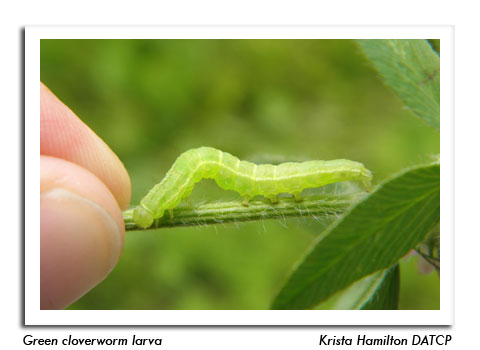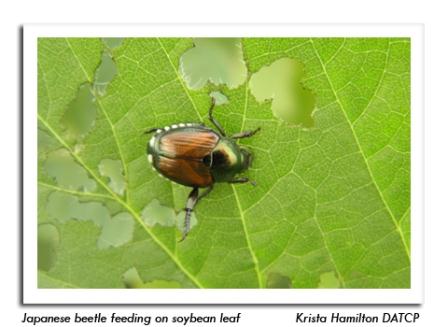
 |
|
|
Soybeans
Volume 61 Number 17 Date 08/25/2016 SOYBEAN APHID - Densities recorded during the annual survey conducted earlier this month were extremely low. The state average count in 170 fields sampled from July 25-August 10 was only eight aphids per plant, with a range of 0-151 per plant. For comparison, the 2015 survey found an average of 35 aphids per plant, averages in 2013 and 2014 were around 55 aphids per plant, and surveys from 2010-2012 documented densities of 7-16 aphids per plant. The lowest state average in the 16-year history of Wisconsin soybean aphid surveys was seven aphids per plant in 2012. Results of the survey confirm that aphid populations remained low or moderate in most fields this season and widespread treatment for aphid control was not required. GREEN CLOVERWORM - This insect is still common in soybeans across the southern and western areas of the state. However, populations and defoliation are not particularly high. Larvae vary from the intermediate instars to nearly full grown. JAPANESE BEETLE - Defoliation was observed in about 74% of the soybean fields examined during the aphid survey in late July and August, indicating that Japanese beetle (JB) pressure has been more widespread than in recent years. Defoliation estimates were below the 20-30% threshold in the soybean fields surveyed by DATCP, but JB has become an increasingly significant defoliator and agricultural crop pest. Therefore, in 2017 and beyond, it will be important for crops advisors and consultants to understand how to accurately assess JB defoliation rates. The UWEX-recommended procedure is to select a trifoliate leaf from the top, middle and lower third of 10 randomly selected plants. From each trifoliate, discard the most and least damaged leaflets to obtain a sample size of 30 leaflets. Compare the selected leaflets to the illustrations/images in the UW-Madison soybean defoliation guide at http://ipcm.wisc.edu/blog/2012/07/japanese-beetle-scouting-and-thresholds-for-corn-and-soybean/defoliation/ and record the average level of defoliation. Treatment should be considered at 20% defoliation for post-bloom reproductive soybeans and 30% defoliation for pre-bloom vegetative fields. -- Krista Hamilton, DATCP Entomologist 


|
|
|